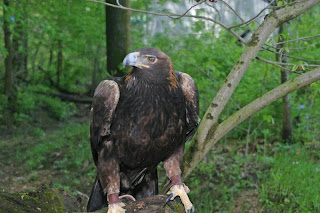The World Bird Sanctuary has a handful of Golden Eagles. One in particular just happens to be one of the sweetest and most well behaved birds we have. Her name is Mariah. Following are some fascinating facts about Mariah and her species.
Mariah - The World Bird Sanctuary's matriarch
To start things off, did you know that the Golden Eagle is Mexico’s national bird? This eagle represents regality, strength and courage to them. The Golden Eagle is arguably the largest eagle in the Northern Hemisphere!
In this photo of Buchanan you can clearly see the golden feathers on his head
The Golden Eagle (Aquila chrysaetos) got its name from the light shimmery golden color on the back of its head. These birds can be found in western North America, northern Africa, Asia and most of Europe. They have a wide range of habitat that can include grasslands, tundra, desert, shrubland, farmland and coniferous forest areas.
Mariah is a truly majestic bird
The Golden Eagle’s current population is doing well and their species conservation status is of least concern. In the wild, a Golden Eagle's lifespan ranges between 15 and 30 years. In captivity they can live up to 50 years. At 41 years of age Mariah is the World Bird Sanctuary’s oldest bird.
As with most birds of prey, male Golden Eagles are smaller than the females. They may range from six to fifteen pounds. Mariah is currently around 12 pounds! She gets up to 14 pounds in the winter, when her body tells her to put on weight for cold weather. Their wingspan can reach up to seven feet.
These eagles are carnivores that eat mostly small mammals, but will also eat carrion (dead animals), birds, reptiles, and occasionally fish. Some Golden Eagles eat tortoises, too. In order to get the meat from inside the shell, they fly up high with it in their talons and then drop it on rocks to break the shell.
Golden Eagles are a monogamous species. Monogamous refers to having only one partner at a time. If their partner passes away they will search for another mate. They usually breed between March and August. Their nests are composed of sticks that are built on top of high cliffs, tall trees or even telephone poles. The females lay from one to four eggs per clutch (a group of eggs). The chicks usually fledge (leave the nest) around 3 months old.
Immature Bald Eagles, such as Norbert above, are often mistaken for Golden Eagles
Golden Eagles and juvenile (young) Bald Eagles look similar to each other, especially at a distance. One way to tell the difference between a juvenile Bald Eagle and a Golden Eagle is to look at their legs - Golden Eagles have feathers that cover their entire leg all the way to the top of the foot, whereas Bald Eagles have featherless lower legs.
Mariah came to WBS from a falconer. The falconer trained her to like him and hunt for other animals in his presence. As birds age they can develop some of the same health problems as humans. They can get cataracts in their eyes, get arthritis or succumb to diseases as their immune systems become weaker. Because of Mariah’s age, she has developed cataracts. She cannot see very well and because of this she is brought inside the wildlife hospital at the end of each day.
Each morning Mariah is taken outside to spend her day outside near Kili, another Golden Eagle, and Duncan, a Wedge-Tailed Eagle. While Mariah can be such a gentle bird to handle, as handlers we can never forget how powerful she can be with her strikingly sharp talons and very strong feet.
You can help support World Bird Sanctuary's mission by adopting Mariah through our Adopt a Bird program. Mariah can be seen daily near the Wildlife Hospital at the World Bird Sanctuary. You should stop on by and visit her! She is very beautiful!
Submitted by Lisbeth Hodges, World Bird Sanctuary Naturalist.








No comments:
Post a Comment